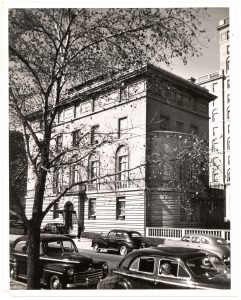We recently processed a small collection of guest books from the President’s House during Nicholas Murray Butler’s administration. These books show the range of events and dinner guests that the University President hosted over 30 years. But the books only record those invited guests and not the students, in particular student protesters, who received a very different reception in May 1936.

The President’s House stands on the northeast corner of Morningside Drive and 116th Street, facing Morningside Park. It was first occupied by President Nicholas Murray Butler after it was constructed in 1912. This official residence on University property was intended to keep the President in close touch with campus life. The house was designed by McKim, Mead and White, the same firm that designed the original buildings on campus. It was modeled on embassies and designed to host events with large numbers of guests. As constructed, the first and second floors, with very high ceilings, contained a library, a dining room, a drawing room, a music room and a large central hall, which forms one large reception room. The third and fourth floors were reserved for the family, guests and servants’ rooms. The kitchen was in the basement.
In February 1936, President Nicholas Murray Butler accepted an invitation to send Columbia delegates to the 550th anniversary of the University of Heidelberg. This action was not well received on campus as the community decried Butler’s perceived support of Nazi Germany. After months of meetings, campaigns, and speeches, Butler had made no response nor changed his plans to send a delegation in the summer.
On May 12, 1936, the local chapter of the American Student Union staged a protest or a “Mock Heidelberg Festival” on South Field, including a book burning (phone books) and the Glee Club singing “Deutschland Uber Alles.” A crowd of about 150 students eventually moved the demonstration from South Field to the President’s House. There, two students from the ASU, Robert Burke and Paul Thomson gave speeches, some profane and obscene remarks were made, and posters were left in the House’s lobby. President Butler, who was entertaining that evening, did not respond to the protestors nor to the press later that evening.

While there were riots that evening with trash fires on 119th Street, $200 worth of damage to the Barnard fence, and police involvement, most of the attention in the aftermath was focused on those who took part in the President’s House protest rally. Their behavior was deemed discourteous, insulting and just disgraceful. Columbia College Dean Herbert Hawkes conducted a five-week investigation into the events. He tried to make clear that while disagreeing with the authorities of the University “was expected and not to be condemned … the question was one of conduct and not of opinions.” Of the two students who made speeches at the President’s House, Thomson apologized but Burke did not. As a result, Burke’s registration was cancelled.
Knowing about this controversial and infamous event in Columbia history, there was still an unanswered question: who was at the dinner at the President’s House that night. The guest books reveal that on May 7, Butler hosted a dinner for Prince Hubertus zu Lowenstein and on May 16, a dinner for Sir Frederick Williams-Taylor. The names of those in attendance at the ill-fated dinner on May 12, 1936 remain a mystery.